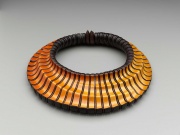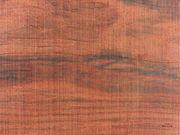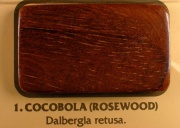Difference between revisions of "Cocobolo"
(username removed) |
|||
| (4 intermediate revisions by 3 users not shown) | |||
| Line 1: | Line 1: | ||
| − | [[File:2006.71-SC191988.jpg|thumb| | + | [[File:2006.71-SC191988.jpg|thumb|Norwegian necklace<br>MFA# 2006.71]] |
== Description == | == Description == | ||
| − | + | [[File:cocobolo tangential.jpg|thumb|Cocobolo]] | |
A hard, durable wood obtained from several South American trees of the genus ''Dalbergia'', especially ''Dalbergia retusa''. Cocobolo wood has a medium fine texture and is usually a reddish brown color with dark wavy figuring. It is dense and difficult to cut or carve. The wood is primarily used for making knife handles and small carved items. Cocobolo wood is naturally resistant to decay, but only small quantities of the wood are used each year. | A hard, durable wood obtained from several South American trees of the genus ''Dalbergia'', especially ''Dalbergia retusa''. Cocobolo wood has a medium fine texture and is usually a reddish brown color with dark wavy figuring. It is dense and difficult to cut or carve. The wood is primarily used for making knife handles and small carved items. Cocobolo wood is naturally resistant to decay, but only small quantities of the wood are used each year. | ||
| − | + | [[File:cocobolo EWC.jpg|thumb|Cocobolo]] | |
== Synonyms and Related Terms == | == Synonyms and Related Terms == | ||
''Dalbergia retusa''; bois de rose du Honduras (Fr.); cocobola | ''Dalbergia retusa''; bois de rose du Honduras (Fr.); cocobola | ||
| − | + | == Risks == | |
| − | |||
| − | |||
| − | |||
| − | |||
| − | |||
| − | |||
| − | |||
| − | Contact or inhalation may cause irritation and allergies. | + | * Contact or inhalation may cause irritation and allergies. |
| + | * Colors are lighter when freshly sanded/cut, and darken with age | ||
| + | ==Physical and Chemical Properties== | ||
| − | == | + | * Density = 50-60 ppcf |
| + | * Heartwood = Ranges from yellow, orange, red, and shades of brown with streaks of black or purple | ||
| + | * Sapwood = typically a very pale yellow. | ||
| + | * Grain/Texture = straight to interlocked, with a fine, even texture. | ||
| + | * Luster = good | ||
| + | * Durability : Very good; resistant to insect attack; natural oils are reported to give it good resistance to degrade from wet/dry cycles. | ||
| − | + | ==Working Properties== | |
| − | + | High oil content in this wood can occasionally cause problems with gluing. Also, the wood’s color can bleed into surrounding wood when applying a finish, so care must be taken on the initial seal coats not to smear the wood’s color/oils into surrounding areas. Tearout can occur during planing if interlocked grain is present. The wood also has a moderate blunting effect on cutting edges/tools due to its high density. Cocobolo has excellent turning properties. | |
| − | |||
| + | ==Resources and Citations== | ||
| − | + | * The Wood Database: [https://www.wood-database.com/cocobolo/ Cocobolo] | |
| − | * | + | * Random House, ''Webster's Encyclopedic Unabridged Dictionary of the English Language'', Grammercy Book, New York, 1997 |
* ''The American Heritage Dictionary'' or ''Encarta'', via Microsoft Bookshelf 98, Microsoft Corp., 1998 Comment: cocobola | * ''The American Heritage Dictionary'' or ''Encarta'', via Microsoft Bookshelf 98, Microsoft Corp., 1998 Comment: cocobola | ||
| − | * | + | * G.S.Brady, ''Materials Handbook'', McGraw-Hill Book Co., New York, 1971 Comment: p. 210 |
| − | * | + | * Ralph Mayer, ''A Dictionary of Art Terms and Techniques'', Harper and Row Publishers, New York, 1969 (also 1945 printing) |
| − | * | + | * F. H. Titmuss, ''Commercial Timbers of the World'', The Technical Press Ltd., London, 1965 |
| − | * | + | * Michael McCann, ''Artist Beware'', Watson-Guptill Publications, New York City, 1979 |
[[Category:Materials database]] | [[Category:Materials database]] | ||
Latest revision as of 14:34, 1 July 2022
Description
A hard, durable wood obtained from several South American trees of the genus Dalbergia, especially Dalbergia retusa. Cocobolo wood has a medium fine texture and is usually a reddish brown color with dark wavy figuring. It is dense and difficult to cut or carve. The wood is primarily used for making knife handles and small carved items. Cocobolo wood is naturally resistant to decay, but only small quantities of the wood are used each year.
Synonyms and Related Terms
Dalbergia retusa; bois de rose du Honduras (Fr.); cocobola
Risks
- Contact or inhalation may cause irritation and allergies.
- Colors are lighter when freshly sanded/cut, and darken with age
Physical and Chemical Properties
- Density = 50-60 ppcf
- Heartwood = Ranges from yellow, orange, red, and shades of brown with streaks of black or purple
- Sapwood = typically a very pale yellow.
- Grain/Texture = straight to interlocked, with a fine, even texture.
- Luster = good
- Durability : Very good; resistant to insect attack; natural oils are reported to give it good resistance to degrade from wet/dry cycles.
Working Properties
High oil content in this wood can occasionally cause problems with gluing. Also, the wood’s color can bleed into surrounding wood when applying a finish, so care must be taken on the initial seal coats not to smear the wood’s color/oils into surrounding areas. Tearout can occur during planing if interlocked grain is present. The wood also has a moderate blunting effect on cutting edges/tools due to its high density. Cocobolo has excellent turning properties.
Resources and Citations
- The Wood Database: Cocobolo
- Random House, Webster's Encyclopedic Unabridged Dictionary of the English Language, Grammercy Book, New York, 1997
- The American Heritage Dictionary or Encarta, via Microsoft Bookshelf 98, Microsoft Corp., 1998 Comment: cocobola
- G.S.Brady, Materials Handbook, McGraw-Hill Book Co., New York, 1971 Comment: p. 210
- Ralph Mayer, A Dictionary of Art Terms and Techniques, Harper and Row Publishers, New York, 1969 (also 1945 printing)
- F. H. Titmuss, Commercial Timbers of the World, The Technical Press Ltd., London, 1965
- Michael McCann, Artist Beware, Watson-Guptill Publications, New York City, 1979


